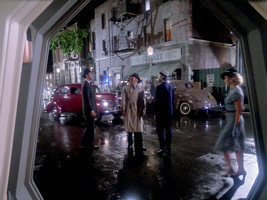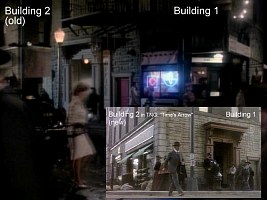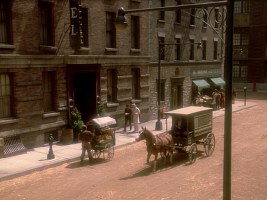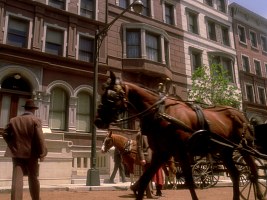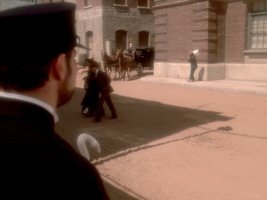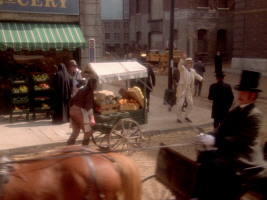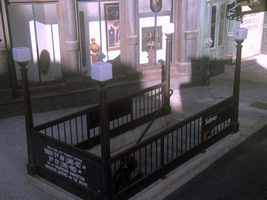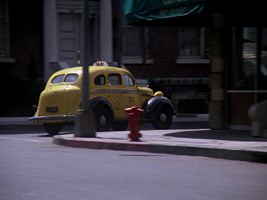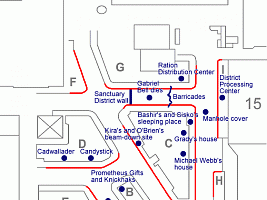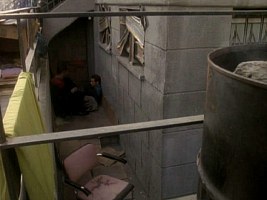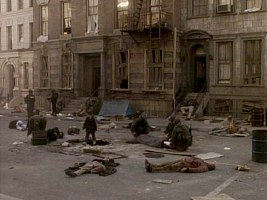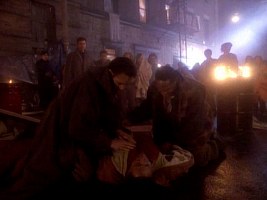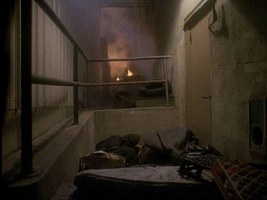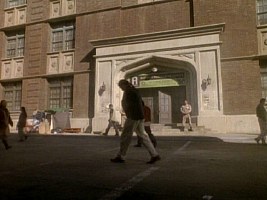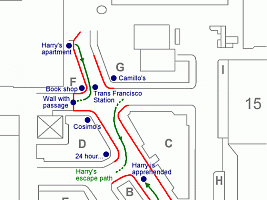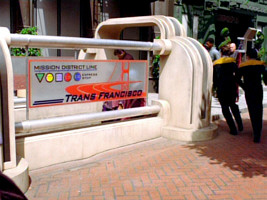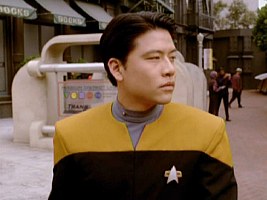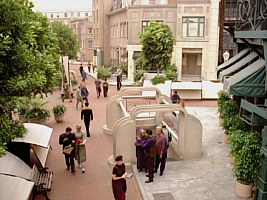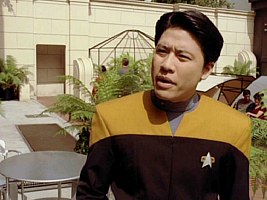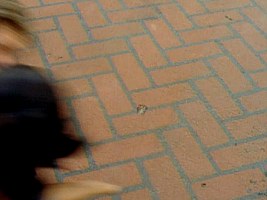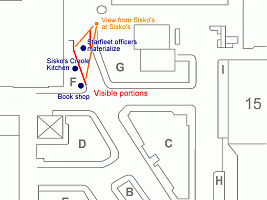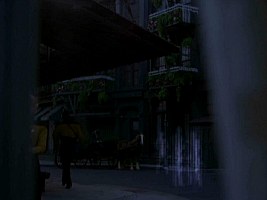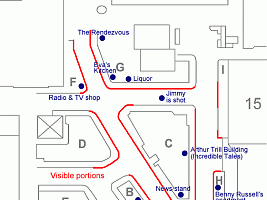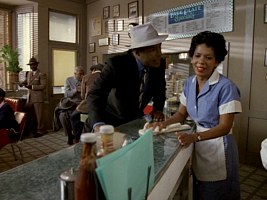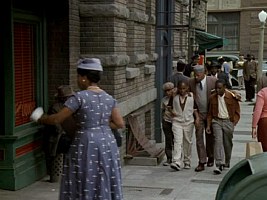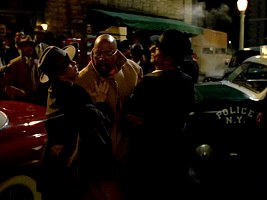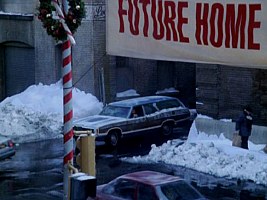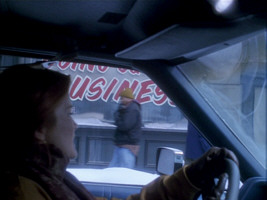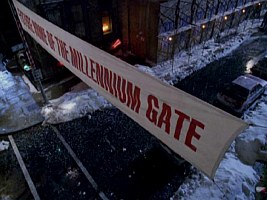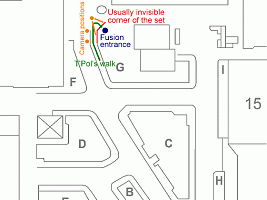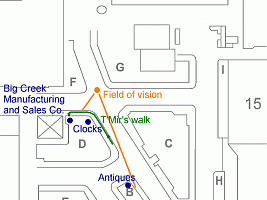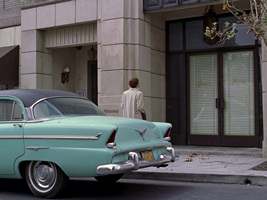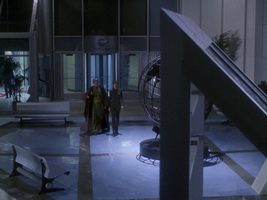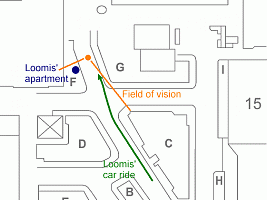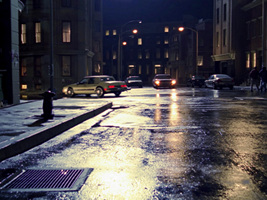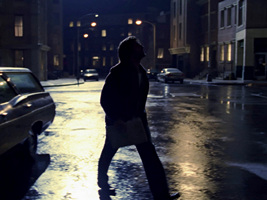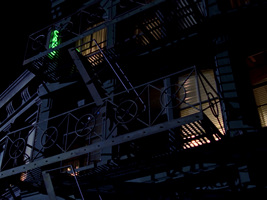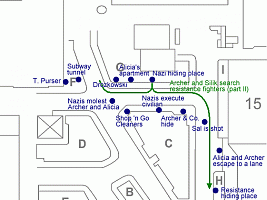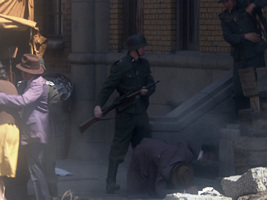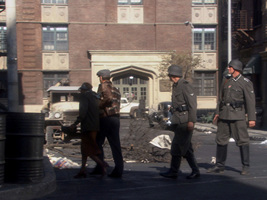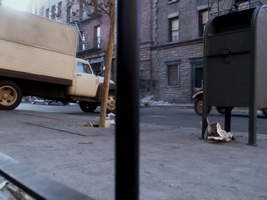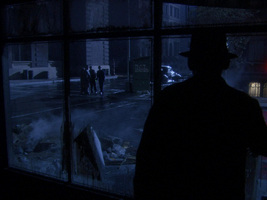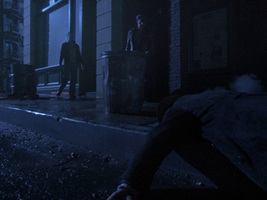Re-Uses of the New York Streets Set
by Jörg Hillebrand and Bernd Schneider
The New York Streets set is a permanent set on the Paramount Pictures lot. It was erected after a devastating fire that had destroyed the old street set in 1983. It is not surprising that this set was used very often in Star Trek's more recent history whenever the script called for a "generic American city" as a location (not restricted to NYC).
We could see the New York Streets set in very different roles in the following TNG, DS9, VOY and ENT episodes (in airing order):
1. Holographic version of San Francisco in 1941 in TNG: "The Big Goodbye" (Picard's "Dixon Hill" creation)
2. San Francisco in 1893 in TNG: "Time's Arrow II" (where Data ends up losing his head)
3. "Keystone City", a generic American city of the 1950s in TNG: "Emergence" (created on the holodeck by the emergent lifeform)
4. San Francisco in 2024 in DS9: "Past Tense I/II" (during the Bell Riots)
5. Parallel reality version of San Francisco in 2372 in VOY: "Non Sequitur" (a reality in which Harry Kim has remained on Earth)
6. New Orleans in 2372 in DS9: "Homefront" (focusing on Sisko's Creole Kitchen)
7. Fictitious version of New York in the 1950s in DS9: "Far Beyond the Stars" (as part of Ben Sisko's "Benny Russell" vision)
8. New Orleans in 2375 in DS9: "Shadows and Symbols" (focusing on Joseph Sisko's restaurant again)
9. Portage Creek, Indiana, in 2000/2001 in VOY: "11:59" (a city that exists in the Star Trek Universe and is the "Future Home of the Millennium Gate")
10. Generic street with a night club in ENT: "Fusion" (in T'Pol's vision, a brief scene focusing on the "Fusion" club)
11. Pittsburgh in 1957 in ENT: "Carbon Creek" (where T'Mir sells the idea of Velcro to a company called "Big Creek")
12. San Francisco in 2153 in ENT: "The Expanse" (actually just the Fleet Operations Center)
13. Detroit in 2004 in ENT: "Carpenter Street" (the street where Loomis, the employee of the blood bank, lives)
14. Parallel reality version of Brooklyn, New York in 1944 in ENT: "Storm Front I/II" (occupied by the Nazis)
The following analysis identifies where on the New York Streets set the buildings featured in the episodes are located, and which parts of the sets have been used in different functions.
General Information
The old New York Streets set included many buildings that were over 50 years old and that had appeared in several classic movies. It burnt completely down on August 25, 1983, incidentally just a couple of days after the filming of "Star Trek III: The Search for Spock" had started. The new set was erected in its place in the following years.
The New York Streets set is embedded between the buildings 32, 15, 14, the famous Water Tower and the Archive. The southern wall of the Archive is painted with a blue sky and is known as the site where the shots with the sinking Bird-of-Prey were filmed for "Star Trek: The Voyage Home". The parking lot in front of the sky wall was converted to a huge swimming pool for that purpose.
The set measures roughly 120m by 80m and consists of nine comparably small building blocks labeled A through I and a network of streets. From most points on the streets it is possible to film an angle and the corresponding reverse angle, in order to provide the scenes with a sense of depth and realism. The blocks A, F, I and H, however, appear to be only façades that cover the actual walls of the buildings 32, 15, 14 and the Archive, respectively. Real interiors (to be dressed as shops) exist in the block G, and probably in B, C, D and E as well. Only block C is complete in a way that it may filmed from any side.
We based our investigation with the letters for the building blocks on an older map of the Paramount lot. On a more recent map for visitors the set is sub-divided in "neighborhoods" of New York such as "Brooklyn", "Greenwich Village" or "Financial District". There is also a new portion called "Chicago" that must have looked different at the time Star Trek episodes were filmed in the set (it was never really visible). In 2016, the street between blocks F/G and D/C was dedicated to Leonard Nimoy.
The set is built to allow filming of settings from the 19th century to the far future. The oldest looking buildings are located in the northeast corner of the set, while some modern architecture can be found in the southwest in the block E and the southern façades of block D (the "Financial District"). While block G is an area dominated by shops and other small businesses, block C comprises some residential buildings and block H some upper-class apartments.
Analysis
Note that in the following the directions "north", "south", "west" and "east" refer to the maps of the set, and also coincide with the actual orientation of the Paramount lot. "Up", "down", "left" and "right", on the other hand, always indicate where on a screen cap something can be found.
TNG: The Big Goodbye
We previously assumed that the set first appeared in TNG: "Time's Arrow", owing to information that it was completed as late as in 1992, which would exclude anything prior to TNG's sixth season. However, Jörg discovered parts of the set that could be seen as soon as in the first-season episode "The Big Goodbye".
The set looked somewhat different at that time though. Looking through the arch into the holodeck across "Avenue H", we can see building 3 to the left and building 1 to the right, which we can identify as the ones on the eastern corner of block C and of block G, respectively. Building 3 will reappear in DS9: "Past Tense", building 1 in TNG: "Time's Arrow". A street runs between these two buildings in later episodes. In "The Big Goodbye", however, we can see building 2 in the place of the later street. Even more curiously, the façade of the demolished building 2 was obviously preserved. In later appearances of the set, notably in "Time's Arrow", we can see that it was turned 90 degrees clockwise and now forms the southern front of building 1 in the apparently newly created or completely rebuilt "Brooklyn" part of the set.
TNG: Time's Arrow II
The New York Streets backlot wasn't completed in time for the filming of episode of "Time's Arrow I", so all exterior shots were filmed at historic Pico House and along Olvera Street in old Los Angeles. All exterior footage for Part II was filmed on the Paramount backlot, however.
Data finds himself in San Francisco in 1893. He enters the Hotel Brian, a building with characteristic relief masonry in the ground floor. It can be found in the south center of block G. One exit of the hotel, through which Data escapes when Clemens/Twain pursues him, is located at the southwestern corner of the block, in the shop later known as Eva's Kitchen in DS9: "Far Beyond the Stars". In the building right of the hotel we can see a grocery behind the two awnings. This is the building whose eastern façade was visible as #3 as early as in "The Big Goodbye" and whose new southern façade is taken from the now demolished building 2. The street in front of the awnings is the former site of #2.
Around the corner of the grocery store we find the entrance to the Sisters of Hope Hospital (which was the main and only front entrance of #2 in "The Big Goodbye", still in the same building. The next shop to the right is "Pops Candy Store" (not visible on our screen cap).
On the search for Data the crew led by Captain Picard, posing as actors, rent an apartment in the building block H ("Brownstones"), in the second from the left out of four buildings altogether. This block is somewhat isolated from the rest of the set. It is unknown what is located in the gap between I and H. Possibly this section is usually not filmable. The only time that we see anything of it will be in ENT: "Storm Front", albeit at night.
When Data's coach turns around the northern corner of block I, we get a look of an ancient-looking stone building. This is an isolated building of the set, apparently labeled "Local Trucking". Looking more closely, we can make out the bright gray wall of the Paramount storage building in the upper center of the screen capture.
It is left to note that for "Time's Arrow II" the usual asphalt of the street was covered with sandy soil.
TNG: Emergence
In "Emergence" there is an art gallery in the corner building of block F, with a subway station right in front of it. The station is a permanent feature of the set, but the railing can be removed and the stairs are covered whenever needed. The labeling of the station says that this is New York City. The building to the right will later prominently appear as Sisko's restaurant in DS9: "Homefront". In "Emergence" its door is still closed with a blind labeled "29 - No Freight". On the other side of the street, in block G, we can find a liquor store, a pharmacy and a tailor (from left to right around the corner).
After their arrival in "Keystone City" Data accesses a control console underneath a manhole lid, which can be found in the middle of the street crossing between F, G, C and D. Then a taxi appears from the north, makes a right turn into the street between C and G and heads straight for Data. With a fast leap to the side the android averts the collision and sees how the taxi makes another right turn. Logically the car should now be in the street between F and G, heading north. But actually the scene was filmed between H and C at the southeastern edge of the set. What we should see is the subway and art gallery, what we actually see is the brick building A. Why? Looking in western direction Data would look at the edge of the set, which would have to be specially dressed for this occasion, for instance with a wall as it will be done for VOY: "Non Sequitur". In order to save costs, the shot was simply done at a place where there are filmable façades on either side too, and in addition the building A straight ahead, although the shape and angle of that crossing is not the same.
The hitman, who is carrying a brick stone, inserts it into a wall under construction, which is locatedat the northern side of block C. The next building to the left houses a barber shop and has a characteristic basement access that is extended around the corner and that will play a role in several later episodes.
The hitman can also be seen from behind, walking down the street just in front of building B with the characteristic columns.
DS9: Past Tense I/II
Sisko, Bashir and Jadzia are found at a modern-looking subway station, which is located in front of block E. Sisko and Bashir are homeless as it seems and are taken to the Sanctuary District A (the "A" is from the episode and does not denote a building block!). When they are apprehended, we can make out a building at the rear end of block B in the background, with an old-style shop named "Prometheus Gifts and Knicknaks". It is the only time in Star Trek that we can see this part of the set. Still behind the shop, on the left, the buildings of block C are located, where Kira and O'Brien will beam down some time later.
Unlike Sisko and Bashir, Jadzia is lucky and Chris Brynner takes care of her. His office building in steel-and-glass style is located in block E, directly behind the station. When Brynner and Jadzia enter the building, we can also see the southern façades of block D on the right side. Like the entire block E, they are quite modern, and are obviously not supposed to be visible in any settings of the 1950s or earlier. This is the "Financial District" portion of the set.
At the entrance but still outside the Sanctuary District we can see some homeless people and a burning oil barrel in front of the roller blind labeled "29 - No Freight" that is still the same as in TNG: "Emergence". The wall separating the Sanctuary District from the privileged rest of the city is located just between the two buildings that are most familiar as Alexandria Book Shop (VOY: "11:59") and as Hotel Brian (TNG: "Time's Arrow"), respectively. The grocery from TNG: "Time's Arrow" is now a food distribution center, the formerly two awnings have been combined to one, and they will go missing in the course of the following riot.
As all buildings are occupied (or so the janitors say), Bashir and Sisko have to spend the night on a stairway, which is located in the northeastern corner on block C, as previously seen as building 3 in TNG: "The Big Goodbye" and left of the brick wall in TNG: "Emergence". This is also the house in which Grady lives. Around the corner, in the same block two buildings to the south, we find Michael Webb's house with the arched entrance. Bashir helps Webb's injured son. This is also the place where Sisko and Bashir switch to contemporary clothes.
Bell is killed in the street between blocks C and G. We can see the former Hotel Brian behind him. After Bell has been killed, Bashir and Sisko hide in a place that is apparently located somewhere between two of the buildings on the set, with one corrugated and one plaster wall. It may not have been supposed to be filmed in the first place, but was accordingly dressed as a place for homeless people to sleep.
The most prominent building of the episode is the District Processing Center, where Sisko and Bashir are registered and where Bell/Sisko resolves the hostage crisis some time later. This building occupies the entire block I, and it is the only time in Star Trek that it plays a role. It is easily recognizable in other episodes nonetheless, because of its large entrance portal with a pointed arch, and the rosettes vertically placed between the windows, all in bright sandstone color. The manhole lid, through which Jadzia gains access to the Sanctuary District in part II of the double feature is located in the middle of the street near the front entry of this building. We can see Grady's house (building 3 from "The Big Goodbye") in the background when she climbs out.
As already mentioned, Kira and O'Brien materialize at the western side of block C in different eras. In this part of the street we can find residential buildings with stairs down to the basement. There is a bar in one of the basements, in the 1930s as well as in the late 1960s.
VOY: Non Sequitur
Harry Kim's apartment is located in block F at the very northern end of the set ("SoHo"). In the same block, more to the south, we can find the building of Sisko's restaurant, however, with no particular significance yet. There is a book shop at the corner. The generic subway station is now a part of the "Trans Francisco" public transportation and looks much more modern than it used to and will again in DS9: "Homefront". A wall was erected at the very northern end of the street, in order to allow the camera to pan in this direction.
Still more to the south, across the street in block D, we find Cosimo's, where Harry likes to drink a coffee. Across the street, in the corner of block G, we can see something that looks like another coffee shop, named "Camillo's". It is interesting to note that the street to the west ends in yet another wall. Remembering that in TNG: "Emergence" it was avoided to point the camera in this direction when the taxi vanished around the corner, we may conclude that there is usually no wall.
Aside from covering the building behind it, which does not belong to the set, and providing some nice seats at Cosimo's without too many people passing by, the wall fulfills a third purpose in "Non Sequitur". It allows Harry to pass through and emerge somewhere else on the set when he is chased by Starfleet Security. Actually, the next shot shows Harry at the opposite end of the same street, which would be physically impossible, of course. But the camera does not show Cosimo's or another prominent spot that would expose the trick. Harry's escape path is interrupted one more time when he is shown between the building blocks D and B, but is apprehended only a moment later between B and C. When he runs around the corner of block D, he passes a shop that is apparently labeled "24 Hour Banking". Such a sign should be an anachronism in the 24th century, and it is actually still the same as in DS9: "Past Tense".
The episode has some good views of the street between B and C, looking to its south end at building block A, a rather large large brick house with white window frames. On the left side we can recognize the houses of block C with the typical stairs to the basement where Kira and O'Brien materialized in DS9: "Past Tense".
As it portrays 24th century San Francisco, the complete set is devoid any cars or other motorized street traffic. Trees with odd blinds and occasional benches are placed in the center of both portions of the north-south street. Instead of the usual asphalt, the street is entirely covered with red brick pavement. However, looking more closely we can recognize that it is not genuine but something like PVC, since the bricks and the seams apparently form a flush surface. It must have been a considerable effort to dress the set nonetheless.
When Harry and Tom Paris are in some Starfleet facility, they stand between two walls, of which one is covered with corrugated iron and one with plaster, with tubes running in between. This oddly primitive looking place (for the 24th century) is most likely the gap between two of the buildings on the New York Streets set. It looks like it is the very same place that we already saw in DS9: "Past Tense".
DS9: Homefront
We can find Sisko's Creole Kitchen in block F near the northern end of the set. Only the portion of the street where the restaurant is located is shown in the episode. To the left of the restaurant we can make out a book shop, the same as in San Francisco in VOY: "Non Sequitur", and the stairs, now in 20th century style again. They don't necessarily belong to a transportation system, especially considering that they will be removed for DS9: "Shadows and Symbols". Sisko's does not yet have a neon sign in 2372. Actually, it is not recognizable as a restaurant at all except for insiders. It seems Joseph Sisko does not want too many tourists to invade his place at this time.
One mistake in the episode is that Jake and Joseph are watching from a window in Sisko's restaurant how Starfleet personnel materialize outside. But when we are shown what they are seeing, Sisko's is located behind the officers (so Jake and Joseph would look at the place from where they are watching)! The probable reason is that only one side of the set was accordingly dressed for the episode. We may excuse that and simply pretend that all buildings on both sides of the streets look the same, including even the floral decoration.
DS9: Far Beyond the Stars
The first time that Benjamin Sisko is pulled into the fictitious version of New York, he bumps into a taxi. This happens on the street between the blocks A, B and C. We can recognize the "First National (Bank)" left of the taxi, a building adorned with columns located in block B. On the right side there is the awning of the news stand that will play a role in the following.
Sisko later returns to the illusionary world and finds himself as Benny Russell at the aforementioned news stand where "Nog" is working. It is located at the southern end of block C. We look into the street between the blocks B, D, F on the left and C, G on the right in northern direction, up to the corner building of block F with the stairway to the subway. To the left in front of that building we can also make out the former Cosimo's from VOY: "Non Sequitur", now with rounded instead of straight canopies.
The office building of the Incredible Tales magazine, for which Benny is working, is located around the right corner, at the eastern end on block C. It is named "Arthur Trill Building" and sports an arched entrance. It is the same as the house of Michael Webb from DS9: "Past Tense".
Benny Russell's apartment can be found just across the street in the block H adjacent to Paramount's building 14. It is the second house from the left, the same in which already Picard and his crew stayed in TNG: "Time's Arrow". We can see Benny work through the bay window at night.
Russell also encounters a preacher (Joseph Sisko) between a radio & TV shop in block F and a subway station, the place we could already see from the news stand. The subway station is the one we already know since TNG: "Emergence", the former art shop and book shop was accordingly modified. Ironically, in a manner of speaking, Joseph Sisko appears just a few meters away from his restaurant!
Just vis-à-vis of the radio shop and the subway, we find Eva's Kitchen, the diner where Cassie (Kasidy) is working, in block G. It can be identified as the corner building with the big arched windows on the ground level. It was labeled "Camillo's" in VOY: "Non Sequitur". It is noteworthy that the interior of Eva's kitchen was built on location, with the advantage that no unnatural cuts were necessary when someone entered, and that it was possible to look at the streets outside the window. In block G, on the right side of Eva's Kitchen, we can glimpse a liquor shop when Benny Russell walks along the street with some children in front of the former Hotel Brian.
In the same block, two buildings north of Eva's Kitchen, "The Rendezvous" is located, featuring an illuminated awning. Benny and Cassie leave this place just before Jimmy (Jake) is shot by the racist police officers "Dukat" and "Weyoun". When they hear gun shots, Benny and Cassie rush into the street between C and G where Jimmy is lying on the ground. We can see the former grocery in the background and a small part of the block I.
DS9: Shadows and Symbols
Although it looks like that, no new scenes were filmed in the New York Streets set for this episode. All exteriors of Sisko's Creole Kitchen are digitally modified stock footage from DS9: "Homefront".
For the day views a new illuminated advertising was inserted, the subway stairs were removed and the right lantern was modified to a flag staff. The rest remained exactly the same, even the passers-by and the flowers on the balconies. Interestingly the night scenes are essentially stock footage too, although they required more extensive adjustments to change the overall hue and brightness and to let not just the neon sign, but also the windows appear lighted. The difficulty to correctly reproduce the light of a big lantern may have been the motivation to get rid of it and replace it with the flag pole.
VOY: 11:59
There is a discontinuity already at the beginning of the flashback, when Shannon O'Donnell drives into city. In the very first shot taking place in Portage Creek we can see her car pass by the ancient stone building that already appeared in TNG: "Time's Arrow", taking the same way around the two corners as Data with his coach. We can see the block I with the District Processing Center from DS9: "Past Tense" on the right. As she approaches the " Future Home of the Millennium Gate" banner that spans across the street between the blocks G and C, there is a cut. The next shots suddenly show her car on the street between F and G! She passes The Morning Observer and a women's apparel shop that is "going out of business". The apparel shop, located in the corner building, previously appeared as Eva's Kitchen in DS9: "Far Beyond the Stars". On the crossing, right above the manhole lid from TNG: "Emergence", she bumps into another car. The most likely reason for the discontinuity is that the script called for a wide-angle exterior shot as an opener. This would not have been possible on the street on which O'Donnell has the accident.
Henry Janeway's Alexandria Book Shop is the next shop to the right in block G. It was a tailor shop in TNG: "Emergence" and a liquor shop in DS9: "Far Beyond the Stars", both times without further significance.
Also in this episode, we can see a bar in the same basement entrance in the corner building of block C where Sisko and Bashir slept in DS9: "Past Tense". A red neon arrow points to the entrance. Interestingly, like already in TNG: "Emergence", there is a scaffold on the wall of this building. We also get a good view of the banner with the more or less macabre words "Future Home of the Millennium Gate" at the eastern end of the street.
ENT: Fusion
The streets set is visible only briefly when T'Pol, in an illusion sequence, walks along the street to a club called "Fusion". It is located at the very northern end of the set, in block G. In the same place we could already see "The Rendezvous" in DS9: "Far Beyond the Stars", as indicated by the features of the building and by the awning, which are still the same. For "Fusion" the entrance was moved to a corner possibly beyond the normal set border.
ENT: Carbon Creek
T'Mir is in Pittsburgh to sell the secret of what should become known as Velcro. With the camera looking south, we can see how T'Mir walks along block D. The camera is located on the street crossing near Sisko's restaurant. In the background we can recognize an antiques shop, still in block B. We could previously see this building with the two columns in TNG: "Emergence" and as a bank in DS9: "Far Beyond the Stars".
The camera position follows T'Mir's movement, and we can see her walk by a shop selling clocks that used to be Cosimo's in VOY: "Non Sequitur". Finally, she arrives at the Big Creek Manufacturing and Sales Co., a building that has not been visible so far. The camera position is quite close, as this is the edge of the set (in "Non Sequitur" a wall allowed to film the place from different angles).
ENT: The Expanse
Only a small portion of the set appears in this episode. When T'Pol and Soval leave the Fleet Operations Center of Earth Starfleet in San Francisco, we can recognize that it is the only modern building of the set. It is the same building in block E that previously appeared as the Brynner Information Systems building in DS9: "Past Tense".
ENT: Carpenter Street
We can see the set twice in this episode. At the beginning Loomis parks his car vis-à-vis his apartment. The apartment is in the same building as Sisko's restaurant, as we can tell from the fire ladders, the balconies and the arrangement of the windows. The stairs to the subway station have been covered. When Loomis tries to escape some time later, we only see a part of the façade before T'Pol disables him with the Vulcan nerve pinch. His house is No. 25.
ENT: Storm Front I/II
In "Stormfront I", we can see how the Nazis execute an inhabitant of block C in front of the building in the northern center of the block. Alicia's apartment is located on the opposite side of the street, in the same building of block G as the Alexandria Book Shop in VOY: "11:59".
Archer and Alicia meet with Carmine in the already familiar subway station of block F. The shop in the background (former art galley, book shop, radio shop) is now labeled "T. Purser". When they go out on the street, two Nazis molest them in the middle of the street between C and G. We can see the entrance to building I, well-known from DS9: "Past Tense", in the background.
Later in the episode, Alicia, Archer, Sal and Carmine hide in the same stairway at the northeastern edge of block C where already Sisko and Bashir spent the night in "Past Tense".
Still later in the first part, the former grocery store on the Hotel Brian side of the street (block G) serves as an observation post at night. We can overlook parts of the block I and block C. At the corner of block C there is a red neon sign, which is still the same as in VOY: "11:59", when it marked the entrance to the bar.
While Sal is killed by the Nazis on the street between C and I after the secret meeting, Alicia and Archer escape to the area between the buildings I and H. Since there is probably no lane between the buildings leading to the east (it would be blocked by the large Paramount buildings 14 and 15), the following scenes were probably filmed somewhere else.
Finally, in part II of the episode, Archer and Silik search for the resistance fighters in the streets. They walk along the southern side of block G, turn right and find the hiding place of Alicia and Carmine in the basement of Benny Russell's house (DS9: "Far Beyond the Stars") in block H.
Conclusion
Summarizing, we could see pretty much of the whole new York Streets set in various Star Trek episodes, and all buildings could be identified. Overall, the set decorators have done a great job to dress the set to look different each time, and re-uses of buildings only become apparent after close examination.
The following image map summarizes some of the most important places of the set across 14 Star Trek episodes.
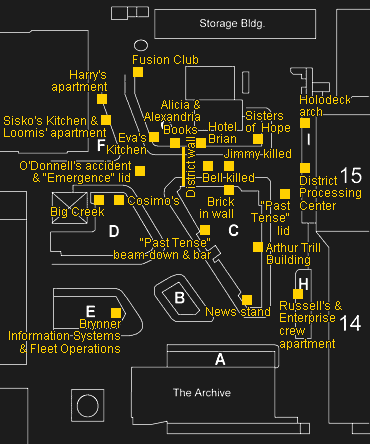
Cross-episode map of the set
Finally, it is needless to say that the New York Streets set appeared in countless TV and movie productions outside the Star Trek Universe. If you have read this article attentively, you will have déjà-vus almost every day.
See Also
Re-Uses of the Little Europe Set - in-depth investigation of the appearances as Sainte Claire and as Fair Haven
Fictional Places on Earth - where Gravett Island, Sainte Claire, Portage Creek, Fair Haven and Carbon Creek could be located
Credits
Thanks to Finntrekkie for pointing us to the video about the 1983 fire.






 Map of New York Streets set
Map of New York Streets set

 Map of New York Streets set
Map of New York Streets set



